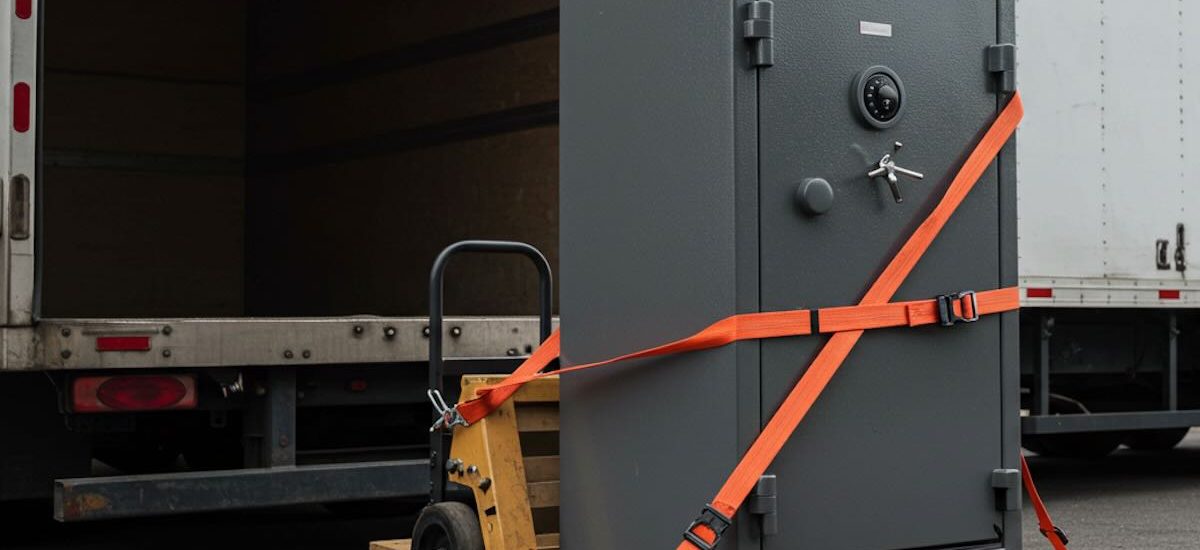Safes are dense, awkward, and easy to underestimate. A little preparation; focused on contents, anchoring, access, and paperwork, helps crews handle the weight safely and keeps you on solid legal footing.
Key Points
- Empty the safe completely and pack contents separately. Firearms should be transported in line with federal and state rules; ammunition is packed apart from firearms.
- Unbolt and de-anchor per the manufacturer’s instructions; note bolt sizes and floor type for re-anchoring at destination.
- Share the empty weight, dimensions, stair/elevator details, and path photos with your mover; many residential safes weigh 600 to 1,500+ lbs and require special gear.
- Protect the home: reserve freight elevators, request a building COI (certificate of insurance) if required, and lay temporary floor protection on travel paths.
- Plan paperwork early if your move is interstate: valuation coverage options (e.g., Full Value Protection) and firearm transport rules may affect timing.
How Do You Choose the Right Handling Plan?
Weight, path complexity, and building rules usually decide whether a standard crew can manage your safe or whether a safe-specialist is a better fit. The summary below can help you weigh the options.
| Option | Best For | Watch-outs |
|---|---|---|
| Standard moving crew + safe dolly | Ground level or elevator access; from 800 – 1,000 lbs; straight paths. | Stairs, tight turns, or heavier safes can exceed safe handling ranges; confirm equipment rating and floor load capacity. |
| Safe-specialist crew (stair climber, liftgate) | >1,000 lbs, stair runs, or complex placements (basement/second floor). | Lead time and cost are higher; buildings may require off-peak scheduling and a COI. |
| Curb-to-garage only | Interim storage; later in-home placement by a specialist. | Two crews mean two handling events; protect slab/floor where it will rest. |
Step-by-Step Preparation
1) Clear the Contents and Separate Categories
Safes should travel empty. Jewelry, documents, electronics, cash, and other valuables are packed separately and kept within reach as you prefer. Firearms (if any) are unloaded and cased, and ammunition is boxed separately. For interstate travel, many readers feel more comfortable following the federal “unloaded and locked, not readily accessible” principle for transport, while also checking state rules at origin, en route, and destination.
2) Power and Moisture Accessories
Unplug dehumidifiers and remove desiccant canisters. Coiling and labeling cords now keeps re-setup simple later. If your safe uses an electronic lock with a battery, note the battery type and pack a spare with your arrival kit.
3) Unbolt and De-anchor the Safe
Many safes are anchored through pre-cut floor holes. Lifting the interior floor panel reveals caps and bolts. Back out the anchors with the correct socket, and keep hardware in a labeled bag. A second person steadying the cabinet while the door is open can prevent forward tipping as bolts come free.
4) Measure, Photograph, and Share the Path
Measurements reduce surprises. Door widths, turns, stair dimensions, and elevator cab size help your mover choose the right equipment. Quick photos of the path (origin and destination) and the safe’s rating plate (model/weight) make planning easier.
5) Protect Floors and Reserve Elevators
A continuous runner (ram board or similar) along the path protects surfaces and reduces point loads. Freight elevator reservations and a building COI, if required, tend to smooth load day. If stairs are unavoidable, your mover may propose a powered stair climber or additional hands.
6) Locking and Handling on Move Day
Close and lock the door so it cannot swing. Keys and combinations travel with you. Crews typically pad and shrink-wrap the cabinet and use a rated safe dolly or pallet jack; ramps and liftgates help maintain control. Because ergonomic limits for one-person lifts are far lower than a safe’s weight, properly rated equipment and team handling are the norm.
7) Placement and Re-anchoring at Destination
Before re-anchoring, check slab or subfloor type and load capacity for the chosen location. After leveling, re-install anchors per the manufacturer’s instructions, then restore accessories (dehumidifier, shelves) and return contents in a clean, dry condition.
Cost & Risk Controls That Actually Help
| Line Item | When It Appears | How to Control It |
|---|---|---|
| Stairs / tight turns | Basement or second-floor placements; narrow halls. | Share exact measurements and photos; consider a safe-specialist with a powered stair climber. |
| Long carry / difficult access | Distant loading zones; no driveway; condo loading docks. | Reserve closest curb/dock; ask management for a dock map; pre-clear timing and path. |
| Anchoring labor | Unbolt at origin and re-anchor at destination. | Have bolt size, floor type, and manufacturer notes ready; stage anchors and tools in one bag. |
| Building requirements | COI, permits, elevator reservations. | Ask two weeks ahead; include fees in the estimate; request off-peak slots if required. |
| Valuation (coverage) | Chosen at booking for interstate moves; varies by state for intrastate. | Price Full Value Protection alongside Released Value and pick the level that fits your risk tolerance. |
Common Mistakes and Calmer Alternatives
- Leaving contents inside. Emptying the safe prevents damage and avoids policy issues. Firearms travel unloaded and cased; ammunition is packed separately.
- Under-sharing details. Noting model, weight, stairs, and elevator size up front helps the crew bring the right gear and the right number of hands.
- Skipping floor protection. A continuous runner and corner guards reduce dents and scratches, especially on long paths.
- Unbolting without support. Having someone stabilize the cabinet while bolts come out prevents a forward tip when the door is open.
- Mixing up valuation and insurance. Released Value (the default on many interstate moves) is minimal; Full Value Protection changes your out-of-pocket risk profile.
FAQ
Do movers allow safes with contents inside?
Most providers ask that safes travel empty for safety, weight, and policy reasons. High-value items are documented and packed separately.
How heavy is “too heavy” for a standard crew?
Many households find that anything near or above a thousand pounds calls for a safe-specialist and powered equipment, particularly with stairs. Even much lighter loads exceed safe one-person lift limits, so rated gear and team handling are typical.
What should I do about firearms and ammo?
Firearms are unloaded, cased, and transported in line with federal rules and the laws of each state you traverse. They do not ride inside the safe on the truck. Ammunition is boxed separately according to carrier and local rules. If you own NFA-regulated items, advance approval and specific ATF forms may apply.
How do I handle re-anchoring?
Most manufacturers provide pre-cut anchor points. Having the correct anchors and knowledge of your floor type (concrete vs. wood subfloor) makes re-anchoring straightforward at delivery.
Should I choose Full Value Protection?
Many readers prefer it for peace of mind on high-value, hard-to-replace items. It costs more than the default Released Value and reduces out-of-pocket risk if something goes wrong.
You might also like our guides on controlling access costs and a printable moving-day checklist. If you’re planning an interstate move, the valuation and paperwork notes in the references below can help you compare policies without pressure.
References
- FMCSA – Protect Your Move (consumer rights & required documents).
- FMCSA – Your Rights & Responsibilities When You Move (booklet).
- FMCSA – Liability & Protection (Full Value vs. Released Value).
- ATF – 27 CFR §478.38 (transporting firearms across states).
- ATF – Moving with NFA firearms (Form 5320.20).
- OSHA – NIOSH Lifting Equation
- Liberty Safe – Tips for moving a safe
- Liberty Safe – Use, care, and anchoring notes.
- 49 CFR Part 171 – Hazardous materials, storage incidental to movement
Regulations and building policies vary by state and property. Where ranges are shown, they are planning estimates. Manufacturer instructions should guide anchoring and handling details for your specific model.








